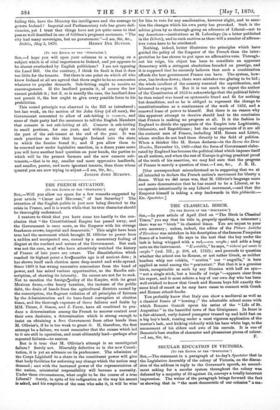THE CLASSICAL BIRCH.
[To THE EDITOR OF THR "SPECTATOR.") Sut,—In your article of April 23rd on "The Birch in Classical Times," you say that its title is, properly speaking, a misnomer ; there was no " birch" in classical times. You are unjust to your own accuracy ; unless, indeed, the editor of the Pitture Antiche d'Ercolano was mistaken in his description of the famous Pompeian fresco of a horsing. He says in the text that the boy under the- lash is being whipped with a rod,—con verghe ; and adds a long note on the instrument "E notabile," he says, " vidersi qui usate le verghe" (vol. III., p. 208, ed. 1762) ; and proceeds to question whether the school can be Roman, or not rather Greek, as neither heathen whip nor eelskin, " amities " nor " anguilla," is here applied as usual among the " prmtextati." But that it is a genuine birch, recognizable as such by any Etonian with half an eye- " not a single stick, but a bundle of twigs "—appears clear from his report, and it must relieve a boy of our own day who has been well swished to know that Greek and Roman boys felt exactly the same kind of smart as he may have cause to connect with Greek and Roman school-books.
You probably know that Italy can show a mediaoval as well as a classical fresco of "horsing ;" the admirable school scene with which Benozzo Gozzoli opens his series of the "Life of St. Augustine" in the beautiful town of San Gimignano. In front is. a fair-skinned, curly-haired youngster trussed up and held fast on a big boy's back, roaring under a most vigorous application of the master's lash, and kicking violently with his bare white legs, to the amusement of his elders and awe of his coevals. It is one of Benozzo's beet studies of character and pleasantest pieces of colour-






























 Previous page
Previous page